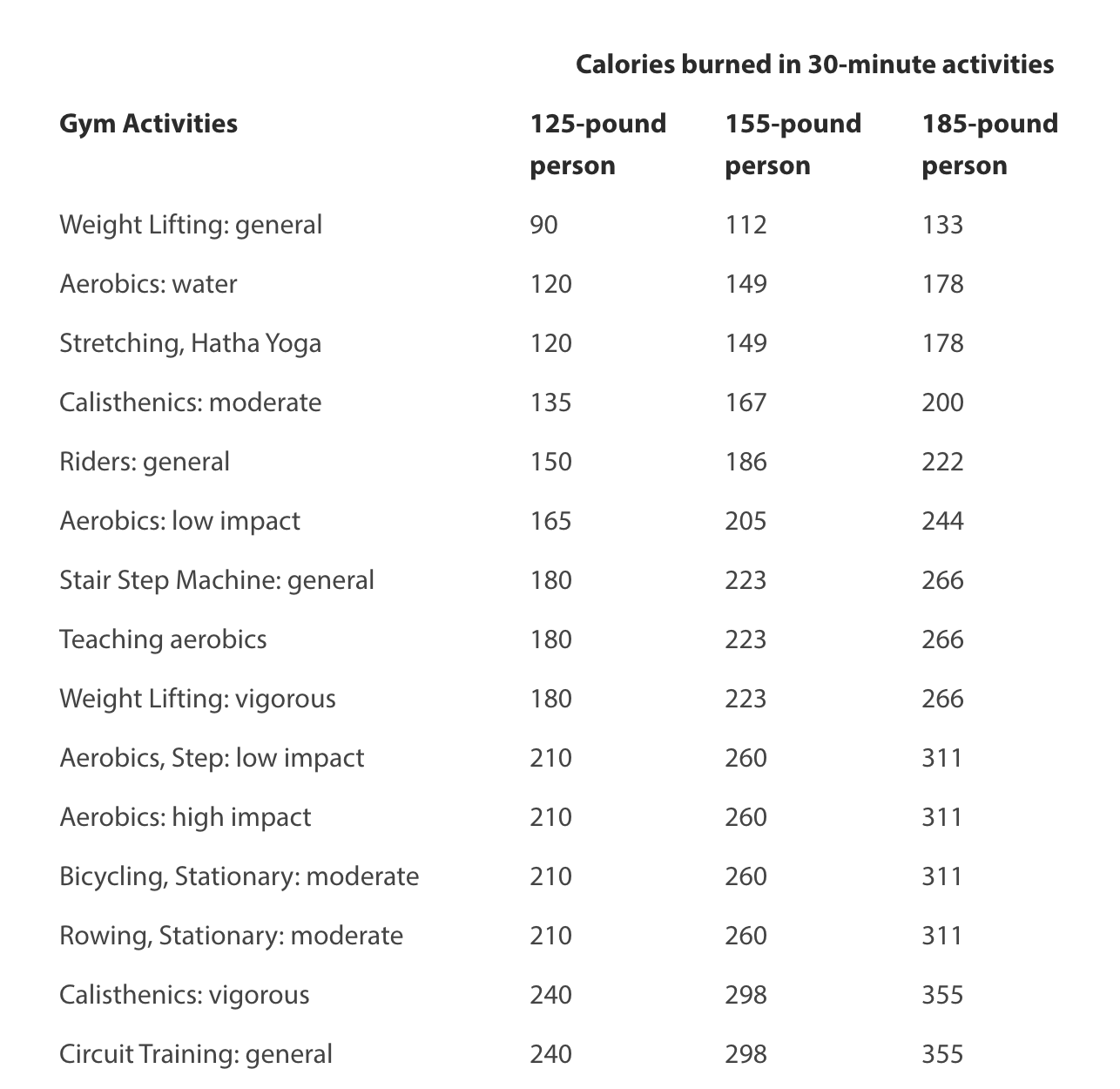Weight Loss Grocery List
The Ultimate Beginner Fat Loss Grocery List
I assume you are here because you are on a mission to lose body fat. Aren’t we all? Pipe down over there lean guy!
You probably have the workout part pretty well handled, and if you don’t I have other blogs for you on that, but you are probably aware that diet plays a big role in this. To really nail your diet, you will have to take some of it into your own hands, more on that in a minute though.
Perhaps you’ve heard someone at your gym, a trainer, or a friend say something to the tune of: "Looking good is 30% and Nutrition is 70%". Or some arbitrary ratio. 30:70 isn't actually that far off. You see, as far as fat loss is concerned - the number one driver is calories in vs. calories out. Some people simply refer to using the acronym "CICO". The CI (calories in) is much easier to manipulate than the CO (calories out). Even the most rigorous workouts don't make nearly the calorie dent people often think (see the table from Harvard Health below) I’ve put a link to the entire article here if you would like to learn more about what you burn.
Sitting down to eat for an hour at most restaurants will easily provide the body with DOUBLE what you burn working out at the same time. In fact, a time.com article cites the average restaurant dish (sides included) clocks in at OVER 1200 calories [2]. Good luck burning that in Your spin class.
It is for these reasons taking control of your calories is the biggest singular thing you can do for your weight loss. In seven years of coaching clients, few habits have helped with fat loss more than eating out less and cooking from home more. To do this, you need to have some foods to choose from that will help you manage CICO, fuel performance, and adhere to it for the long haul! Now, let's get to why you are really here. The grocery list.
What are we shopping for?
foods that help us manage CICO and create a calorie deficit. (A calorie deficit is required for fat-loss, it’s the factor that makes our body turned to stored fat for fuel).
foods we can eat often that fuel performance and are enjoyable. (Even the “healthiest” food is useless if you don’t like it and end up just going out for Mexican- just me? whoops).
foods that are high in protein, fiber, and other nutrients. (Protein is vital for helping us maintain valuable muscle tissue while losing fat. Protein and fiber can also help you stay fuller when eating fewer calories).
foods we like, that help us stay sane that have an "off switch. (These would be things you can say “enough is enough” VS. foods that you do not stop until the bag is empty - we want to limit our exposure to those).
PRO TIP! Hopefully, you saved this article for your trip to the store. If you have I’m going to need you to do me a favor. Park your car as far away from the supermarket as possible. Seriously. The last spot. Making a habit of getting some extra steps can really make a difference. We call this “NEAT” (non exercises activity thermogenesis) and adding a little bit of NEAT here and there can be HUGE for expediting fat loss. One study concluded “The worldwide epidemic of obesity in past decades has contributed to serious health concerns. Apart from poor diet, reduced physical activity and sedentary behavior contribute to the pathogenesis of obesity and the expression of co-morbidities such as type 2 diabetes mellitus. Non-exercise activity thermogenesis is a highly variable component of daily total energy expenditure and essentially a function of environmental and individual factors. Whether caloric overfeeding systematically affects non-exercise activity thermogenesis is a matter of debate, while a negative energy balance due to voluntary caloric restriction can decrease it. As physical activity contributes to weight maintenance and prevention of body mass regain after hypocaloric dietary interventions, increasing non-exercise activity thermogenesis could represent a promising tool for body mass control.”
NOW, WE SHOP.
Fruits and Veggies
Fruits and vegetables are fantastic for anyone looking to lose weight. Don't listen to anything Suzie in accounting has to say about sugar from fruit making you fat, practically, that does not happen often - if ever. Fruits and vegetables are nutrient-dense, high in fiber (keeps us full), easy to add as a side, work great for a snack and have VERY LITTLE impact on CICO.
When I shop for veggies I follow the advice of Skittles commercials, "taste the rainbow". I like to get lots of different colors. Plant's have unique pigments with a myriad of healthy compounds unique to each color and plant. It is for this reason I like to eat things that are green, red, purple, orange, yellow - you name it. In addition to helping with nutrition, it also keeps things fresh, which is really important when it comes to sticking to a diet. Some of my go-to's are:
Mixed greens (salads)
Bell peppers (I chop these and add them to eggs and salads)
Onion (I chop these and add them to eggs and salads)
Mushrooms (I chop these and add them to eggs and salads)
Cucumber (a salad staple)
Avocado (loaded with fiber and healthy fats)
Carrots
Broccoli
Asparagus
Berries (lower in sugar, loaded with fiber)
Kiwi (nutrient-dense, tasty, try it with the skin on)
Apples (great on there own, or added to a salad)
I do not buy all of these every week. Instead, I alternate, try to grab them when they are locally grown, in season, or organic, and keep things fresh. If fat loss is a goal (CICO remaining king) I find adding fruits and veggies to every meal can be a HUGE help in staving off hunger and keeping nutrient intakes high.
Protein
Protein is number one when it comes to macronutrients that are important for fat loss. Macronutrients are the three large nutrient classes in the body we use to classify all the foods we eat (protein, carbohydrate, and fat). For more on macronutrients and how they work in the body, head to the FREE GUIDE section of my website and download the free guide “Nutrition Fundamentals.” Protein plays a vital role in helping us maintain precious muscle tissue. Studies even show that higher-protein diets may be more beneficial for fat-loss. This is likely due to the fact that protein helps keep us full and has a high "Thermic Effect of Food" which is a fancy way of saying, you burn a lot of calories breaking it down and putting it to use.
When I shop for proteins I tend to purchase the three to four of the following:
Lean steaks (sirloin is a favorite)
Ground turkey
Grassfed ground beef
Chicken breast
Pork tenderloin
Salmon
Tuna
Shrimp
Greek Yogurt
Cottage Cheese
Eggs
For plant-based dieters:
Yogurt, Cheese and Eggs
Lentils
Chickpeas
Tempeh
Quinoa
I also like to keep a quality protein powder around at all times, just in case I find I am running behind or need a bump in my protein intake.
Carbs
Carbs or carbohydrates are a pretty big part of the traditional western diet. Their importance and how much of them you should eat are always up for debate amongst nutritional experts. That being said, I think including them into the diet (not eliminating them as many dietary pundits recommend) is a great way to provide fuel for performance and increase adherence.
Here's the problem though, many of the foods people tend to overconsume are often high in carbohydrates. The really precarious stuff often is loaded with carbs, added fats, things that enhance flavor and texture.
Take for example a potato. A white one. Steam that thing up. Appetizing right? No, it's not. Don't lie. You wouldn't eat a steamed white potato if your life depended on it. But you would eat a bag of potato chips. That bag has 3-5 potatoes in it. What's the difference? The inclusion of fats, cooking methods, added salt, more favorable texture.
So, what's the point. Well - to put it simply, when trying to lose fat, you will find it a much easier road if opt for foods that are more like plain potatoes than you will potato chips. You can still buy some chips, but you should make that bag last awhile? capisce? Cool. So here are the carbohydrate sources I like to get:
Potatoes (shocker)
Sweet potatoes
Rice
Oatmeal
Vegetables (I know there is a whole section on this but vegetables PRIMARILY contain carbohydrates).
Beans
Bread
Quinoa
2-3 things you enjoy (cereal, chips, cookies) eaten in moderation with CICO in mind.
To put a bow on carbohydrates, let me say this, carbohydrates are not inherently fattening in any way, shape, or form. In fact, they have fewer calories per gram than fat. They just tend to be represented in that category of foods people deem as “bad” or fattening”. My advice is to observe CICO, eat them around your workouts, and opt for the minimally processed options 80-90% of the time.
Oils/Fats
Many of the foods on this list already contain fat (avocado, the meats, eggs, yogurt). But when it comes to traditional cooking methods, many us cook with fat or oil. I like to keep it very simple and opt for just four primary cooking fats:
Ghee
Grassfed butter
Olive Oil
Avocado Oil
While most fats and oils are fine in moderation these are the four I am most comfortable consuming on a regular basis.
In an effort to make this as simple as possible, allow me to remind you that this list is simply a starting point. It’s a compilation of foods some of which are high in protein, others are nutrient dense and high in fiber, the carbohydrates listed are less likely to overeat than other options - but, none of it is magic. the cico is what makes the magic happen. so i strongly RECOMMEND monitoring your CALORIE intake no matter what you do with this list.
Best of luck,
Coach D.
Resources:
https://time.com/4187120/restaurant-meals-fast-food-calories/
https://www.ncbi.nlm.nih.gov/books/NBK279077/





